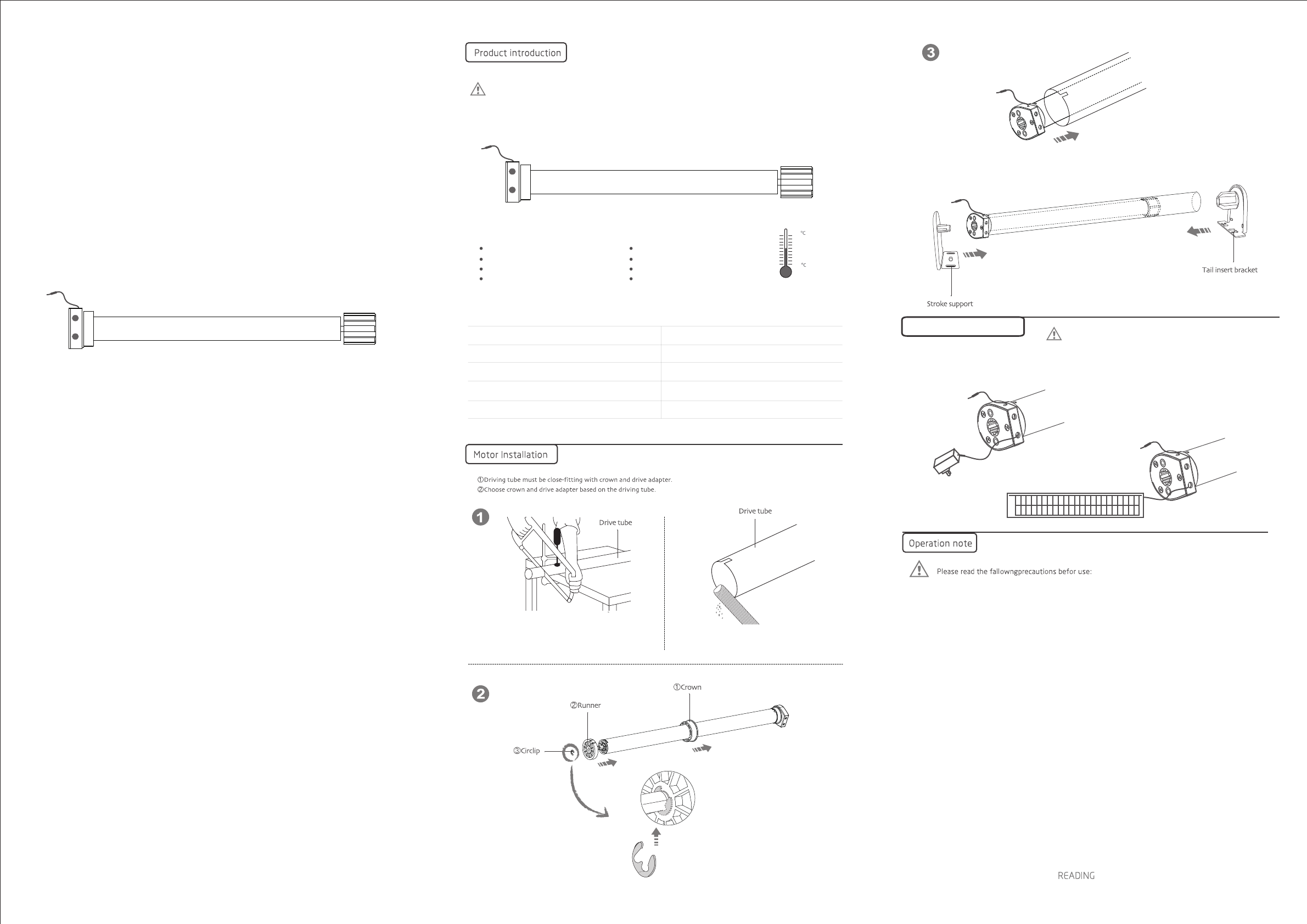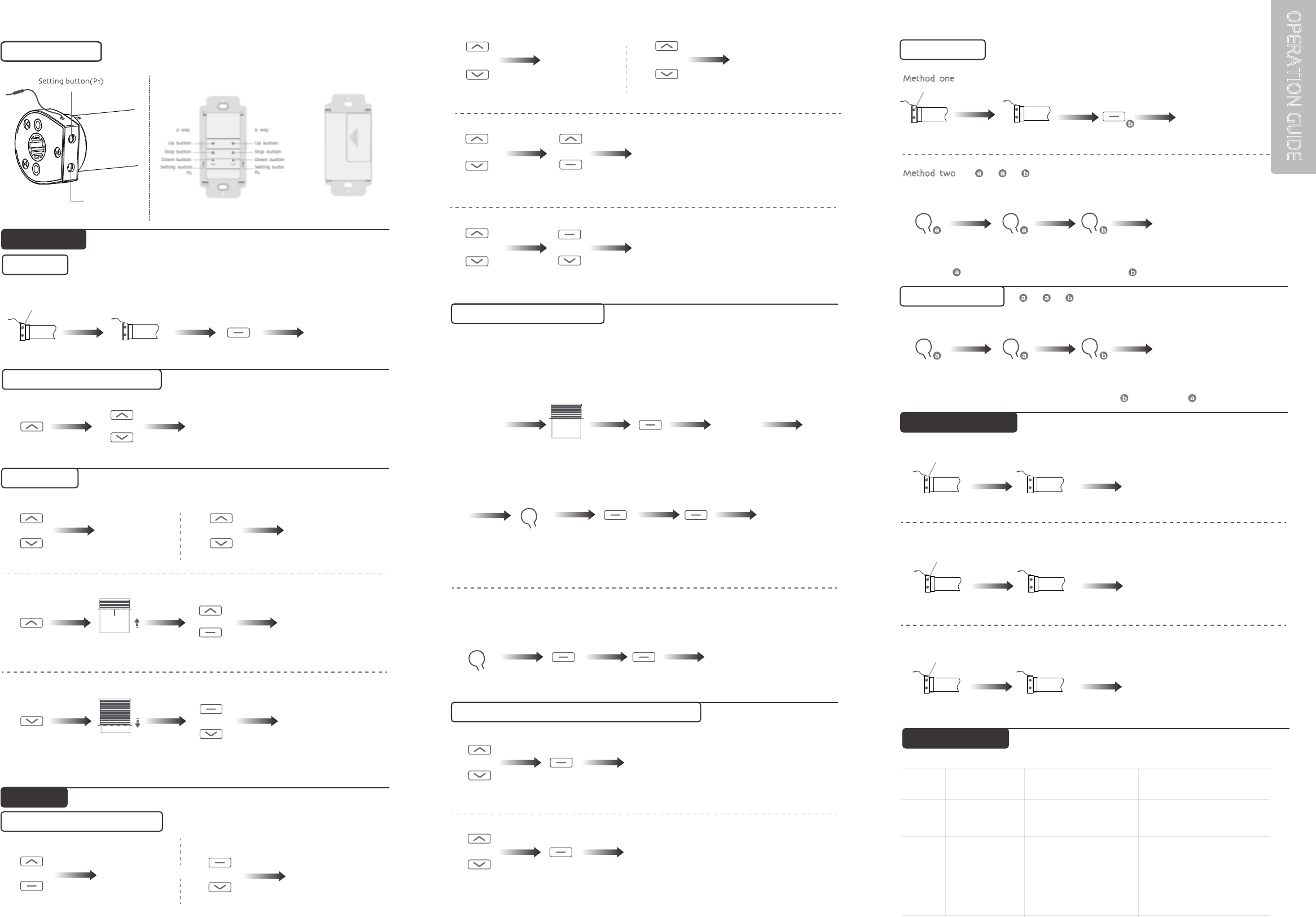NINGBO DOOYA MECHANIC and ELECTRONIC TECHNOLOGY DD1530 Motor Remote Control User Manual DM35LE S
NINGBO DOOYA MECHANIC & ELECTRONIC TECHNOLOGY CO., LTD. Motor Remote Control DM35LE S
User manual

Tubular Motor-
DM18LE/S
Specification
(A-OO)
Rated Voltage(V)
Rated Torque(N.m)
Functional features:
Jogging&tilt function
Set electronic limit
Set /delete the third limit position
Low standby power
Integrated radio control
Setting up+add emitter+delete emitter
Motor direction setting option
Resistance stop function
-10
85
Emission frequency(MHz)
Rated speed(RPM)
1. Please charge the battery and make sure it is fully charged before the first use
2. Don’t operate motors wheuin low wltage alarm:
①Motor stop running When the supply voltage is lower than 7 v, and it will restart
again when the voltage is greater than 7.5V
②If the voltage is less than 10v, the motor will alarm for 10 times to prompt it needs
to be charged every timewhen the motor is working.
3. Optrating:
①The valid interval of the emitter button is 10s,the emitter will quit the set after 10s
②The motor will run or beep for hint,please do the next step after the hint.
4. Set limit position:
①After the up limit and down limit setting,and the up limit down limit and third limit
position are at the same location
②After limit setting,with power and memory function;
③Into the match-code status 2 minutes later, it will quit out the setting limits status
automatically
④It will delete every memory and restore the factory settings
5. When the motor running without any operation, the maximum running time is 6
minutes,it will stop automatically
6. If the emitterlost,please set up again with new emitter
&
The motor has a built-in battery,using the charger to
recharge.You can also use solar panels to charge;when
the battery is low, insert thecharge,charger light shows
red light.batteries isfull when the red light turns to green.
Note:When the battery power is low,you can hear the alarm ten "beep" every time the
motor runs. It indicates the battery needs to be charged. Then plug in the charger with
red light.The light turns green when the battery is fully charged.
Operating
temperature
Parameter
Type
Rechargeable Description
Signal wire
DM18LE/S
0.2N.m
12V
433.925MHz
80RPM

OPERATION GUIDE
1
2
PHENOMENON REASON
The motor alarms
when it is working
PROCESSING METHOD
Charge the battery
The motor is
not running
a,Activate the motor after fully charged
b,Set up the match code
c,Contact the engineers for after-sales
The voltage is low in the
alarm mode
a,The battery is not activated.
b,The emitter is not matched.
c,If press P1 button for a long
time while with no reaction.may
be the power is short-ciralit or the
ciralit board or the motor is
broken.
NUMBER
1, The third limit position setting
①After the up limit and down limit setting, you can set the third limit point between them as the half open position;
Press 2s
Press 1s
Press 1s
Press 1s
Press 5sPress 5s
Press 5s Press 1s
Press 1s Press 1s Press 1s
Press 1s Press 1s
Press 1s
Press 1s
Press 5s Press 1s
Press 2s
Press 2s
Press 2s
Press 2s
Press 2s
Run for hint x2
Run for hint x2
Run for hint x2
Run for hint x2
Run for hint x2
Run for hint x2Run for hint x1Run for hint x1
Run for hint x1 Run for hint x1 Run for hint x1
Run for hint x1Run for hint x1
Run for hint x2Run for hint x1
Run for hint x1 Run for hint x1
If you need to reverse the rotateon of the motor controlled by the emitter,please run the reverse of
direction setting(as lists in the second point of the P1 button setting)
Button specification
P2 P2
P2
4 Add Emitter
P2 →P2 →P2
P2 →P2 →P2
5 Delete one emitter
3 Dot-move/Continuous moving function switch switch
2, The third limit cancel (P2→Stop→Stop)
P1 BUTTON OPERATION
2, Set up limit
3, Set down limit
( Up→Up+Stop)
P2
P2
P2 P2
P2
(Down→Stop+Down)
Run for hint x3
2 The third limit position setting
1 Fine-tune up/down limit position
Enter the limit setting mode
Notes: Repetitive operation dot-move and continuous moving function switching cycle, under the
dot-move function, according to the upor down button more than 2S release motor linkage operation.
or orDot-move Continuous moving
Dot-move function
Continuous moving
function
+
+
++
Adjust the new
up limit point
Adjust the new
down limit point
+Confirm the new up limit point
Confirm the new down limit point
+
+
+
+
or
FACTORY MODE
FACTORY MODE
USER MODE
Functions that can be operated under any mode
Note: After setting up the up and down limit into user mode.
Note: Can not be fine-tune up/down limit position at the same time.
loosen P1
1 Setting up
Run for hint x1
Run for hint x1
loosen P1
Set up is ok
The blind
run down
The blind
run up
The blind
run down
2 The reverse of direction setting
Successful change
the direction
3 limit position
1, Enter the limit setting mode
Confirm the Blind
to stop in the up
limit position
Confirm the Blind
to stop in the down
limit position
The up
limit point
The down
limit point
Set up is ok
Set up is ok
Enter fine-tune
up limit mode
Enter fine-tune
down limit mode
Press 1s
Press 2s Press 2s
Press 1s Press 1s
Press 1s Press 1s Press 1s
Long Press P1
loosen P1
Long Press P1
loosen P1
Long Press P1
loosen P1
Run for hint x2
Run for hint x2Run for hint x1Run for hint x1
Run for hint x2Run for hint x1Run for hint x1
Run for hint x1
Dot-move Continuous moving
or
or
or
or
Press 1s
Press 1s Press 2s
Press 1s Press 2s
Press 2s
Already set
up, down
limit position
Any
position
The third limit position
(any position)
The motor
stops
Set up is ok
Set up is ok
②Long press the stop button for 2s,the roller blinds will move to the third limit
Method two
Method one
Note:Emitter is the one already matched code, while emitter has not
Emitter adding is ok
Emitter adding is ok
One emitter
is deleted
Note:With the same method,you only can delete the emitter not the emitter
1, Activate motor for the first time
2, The reverse of direction setting
3, Restore factory settings
Run for hint x1
Run for hint x2
Set up is ok
Successful change
the direction
Activate is ok
FAULT AND SOLUTION
Recharger or
solar rechargeable
board port
FCC Statements:
This equipment has been tested and found to comply with the limits for a Class B digital device, pursuant to Part 15 of the FCC
Rules. These limits are designed to provide reasonable protection against harmful interference in a residential installation.
This equipment generates, uses and can radiate radio frequency energy. However, there is no guarantee that interference will not
occur in a particular installation. If this equipment does cause harmful interference to radio or reception, which can be determined by
turning the equipment off and on, the user is encouraged to try to correct the interference by one or more of the following measures:
• Reorient or relocate the receiving antenna.
• Increase the separation between the equipment and receiver.
• Connect the equipment into an outlet on a circuit different from that to which the receiver is connected.
• Consult the dealer or an experienced technician for help.
This device complies with part 15 of the FCC Rules. Operation is subject to the following two conditions:
1) This device may not cause harmful interference, and
2) This device must accept any interference received, including interference that my cause undesired operation.
MODIFICATION: Any changes or modifications not expressly approved by the grantee of this device could void the user’s authority
to operate the device.
IC Statements:
-English:
This device complies with Industry Canada RSS standard(s). Operation is subject to the following two conditions: (1) this device
may not cause interference, and (2) this device must accept any interference, including interference that may cause undesired
operation of the device.
2. Changes or modifications not expressly approved by the party responsible for compliance could void the user's authority to
operate the equipment.
-French:
Leprésent appareil est conforme aux CNR d'Industrie Canada applicable aux appareils radio
Exempts de licence. L'exploitation est autorisée aux deux conditions suivantes :
(1) l'appareil ne doit pas produire de brouillage, et (2) l'utilisateur de l'appareil doit accepter tout brouillage radioélectrique subi,
meme si le brouillage est susceptible d'en compromettre le fonctionnement."